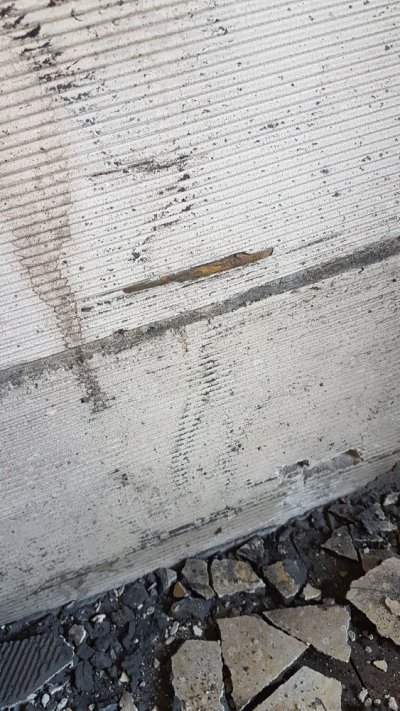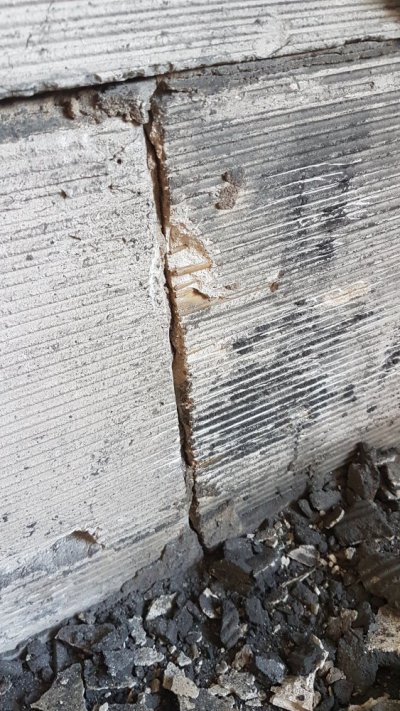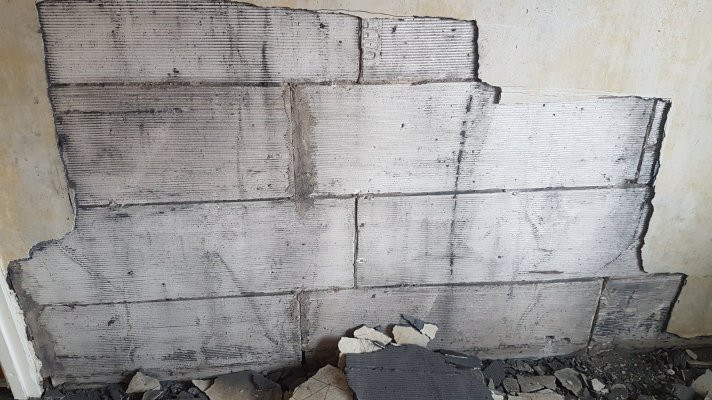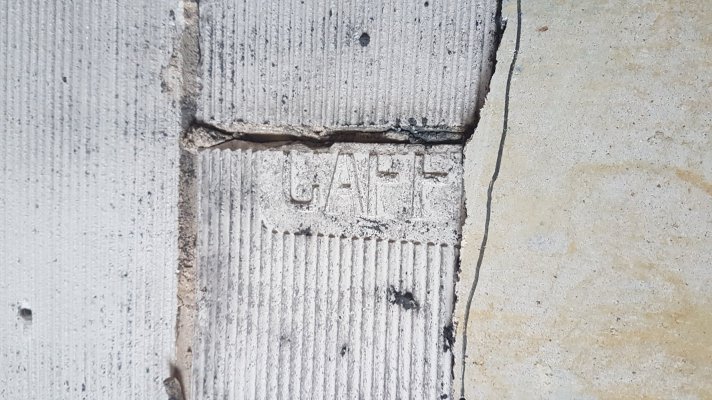Finally (and just in time, given the squeezing rental market) bought myself a 1920s semi in a former pit town near Doncaster. I've been going round the place finding the various things that need looking at, old bodges, etc etc; it's like a used car, but bigger and with fewer rusty bits. At any rate, I've a room upstairs that's surplus to requirements for the moment, and clearly has a fair number of problems, so I've decided to set that room aside as a project room. The aim is to get it at least basically habitable for guests by Christmas.
Among other issues, the plaster on the stud wall connecting the two small rooms upstairs is badly blown on the Project Room's side of the wall; when I moved in, I gave it a tap and it moved quite visibly in relation to the wall. I've set to removing the upper layers of plaster, and in the meantime, decided I'd support some shelves the former owners left behind (which were held up just by a couple of battens and a couple of table legs). First problem: Couldn't find the uprights. Some reading suggested the wall should be lath-and-plaster, but try as I might, finding the uprights was impossible. This was not helped by the fact that there's a layer of grey-black plaster, which turns out to be magnetic, on the wall; my guess is it was bulked out using slag from nearby ironworks. In any event, I decided I'd chance just drilling in where the wall sounded most solid. The wall didn't fall down and the shelves are now much better supported. Hurrah.
Today, I decided it was time to chop away a section of the blown black plaster and see what I found underneath. What I've found is below, and distinctly confusing! (Sorry if the pics are too large, please let me know and I'll resize.) It should be added that, so far as I can tell, this is all original and hasn't been altered since construction; indeed, the adjoining room still has what I suspect is its original plaster, complete with rather nice decorative rosettes and swirls.
Now as I understand it, the usual material for stud walls in the 1920s (which is, I'm told, when this place was built) is lath-and-plaster. I can't, so far, find any laths at all in this wall. I've measured the thickness of the white-grey stuff in the pics, and it's about 3/4" thick and rock-hard. (The water marks are from my splashing it to test absorbency, not a damp ingress issue.) The plant material embedded in the grey substance appears to be reeds, not wooden laths; the wall seems to have been built (judging by this section) out of some sort of blocks of the stuff; and the lines horizontal and vertical seem too neat, to me, to be the result of cracking, which makes me think it might be machine-cut. (Again, the thin gouges in the material on the left are from me taking the loose plaster off with a bolster chisel.) I still haven't seen anything to show there are any uprights in this section, and am a bit baffled as to what this material is and what to expect of it. It's certainly stout enough to withstand multiple hits with a cold chisel and a three-pound club hammer with little more than gouges in it (the two crude, square-shaped holes at the bottom of pic #1).
So, what am I up against?
![20230429_143025[1].jpg 20230429_143025[1].jpg](https://www.periodproperty.co.uk/forum/data/attachments/6/6534-8ab30477ba6e7a2122cd1f79c17c8b4d.jpg?hash=irMEd7puei)


Among other issues, the plaster on the stud wall connecting the two small rooms upstairs is badly blown on the Project Room's side of the wall; when I moved in, I gave it a tap and it moved quite visibly in relation to the wall. I've set to removing the upper layers of plaster, and in the meantime, decided I'd support some shelves the former owners left behind (which were held up just by a couple of battens and a couple of table legs). First problem: Couldn't find the uprights. Some reading suggested the wall should be lath-and-plaster, but try as I might, finding the uprights was impossible. This was not helped by the fact that there's a layer of grey-black plaster, which turns out to be magnetic, on the wall; my guess is it was bulked out using slag from nearby ironworks. In any event, I decided I'd chance just drilling in where the wall sounded most solid. The wall didn't fall down and the shelves are now much better supported. Hurrah.
Today, I decided it was time to chop away a section of the blown black plaster and see what I found underneath. What I've found is below, and distinctly confusing! (Sorry if the pics are too large, please let me know and I'll resize.) It should be added that, so far as I can tell, this is all original and hasn't been altered since construction; indeed, the adjoining room still has what I suspect is its original plaster, complete with rather nice decorative rosettes and swirls.
Now as I understand it, the usual material for stud walls in the 1920s (which is, I'm told, when this place was built) is lath-and-plaster. I can't, so far, find any laths at all in this wall. I've measured the thickness of the white-grey stuff in the pics, and it's about 3/4" thick and rock-hard. (The water marks are from my splashing it to test absorbency, not a damp ingress issue.) The plant material embedded in the grey substance appears to be reeds, not wooden laths; the wall seems to have been built (judging by this section) out of some sort of blocks of the stuff; and the lines horizontal and vertical seem too neat, to me, to be the result of cracking, which makes me think it might be machine-cut. (Again, the thin gouges in the material on the left are from me taking the loose plaster off with a bolster chisel.) I still haven't seen anything to show there are any uprights in this section, and am a bit baffled as to what this material is and what to expect of it. It's certainly stout enough to withstand multiple hits with a cold chisel and a three-pound club hammer with little more than gouges in it (the two crude, square-shaped holes at the bottom of pic #1).
So, what am I up against?
![20230429_143025[1].jpg 20230429_143025[1].jpg](https://www.periodproperty.co.uk/forum/data/attachments/6/6534-8ab30477ba6e7a2122cd1f79c17c8b4d.jpg?hash=irMEd7puei)




